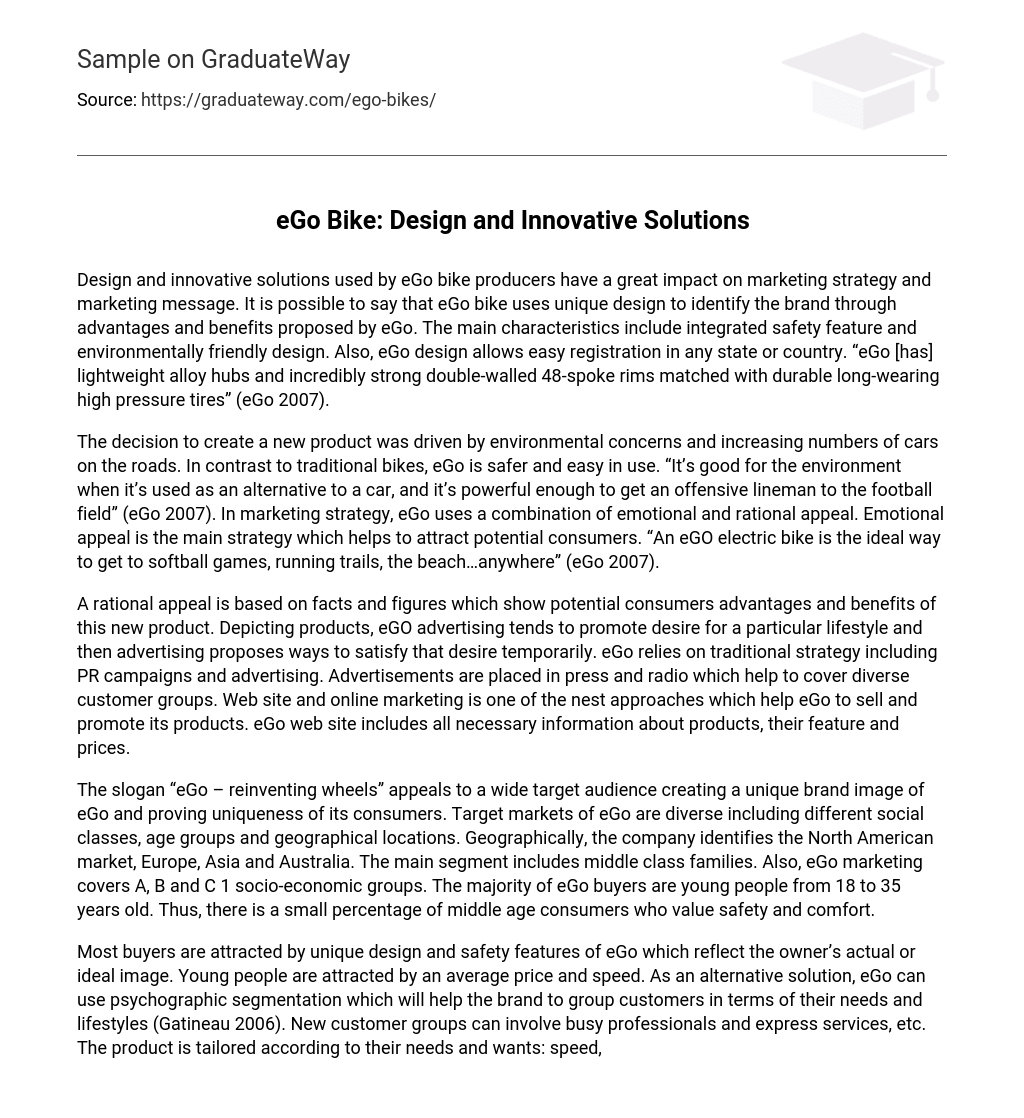Design and innovative solutions used by eGo bike producers have a great impact on marketing strategy and marketing message. It is possible to say that eGo bike uses unique design to identify the brand through advantages and benefits proposed by eGo. The main characteristics include integrated safety feature and environmentally friendly design. Also, eGo design allows easy registration in any state or country. “eGo [has] lightweight alloy hubs and incredibly strong double-walled 48-spoke rims matched with durable long-wearing high pressure tires” (eGo 2007).
The decision to create a new product was driven by environmental concerns and increasing numbers of cars on the roads. In contrast to traditional bikes, eGo is safer and easy in use. “It’s good for the environment when it’s used as an alternative to a car, and it’s powerful enough to get an offensive lineman to the football field” (eGo 2007). In marketing strategy, eGo uses a combination of emotional and rational appeal. Emotional appeal is the main strategy which helps to attract potential consumers. “An eGO electric bike is the ideal way to get to softball games, running trails, the beach…anywhere” (eGo 2007).
A rational appeal is based on facts and figures which show potential consumers advantages and benefits of this new product. Depicting products, eGO advertising tends to promote desire for a particular lifestyle and then advertising proposes ways to satisfy that desire temporarily. eGo relies on traditional strategy including PR campaigns and advertising. Advertisements are placed in press and radio which help to cover diverse customer groups. Web site and online marketing is one of the nest approaches which help eGo to sell and promote its products. eGo web site includes all necessary information about products, their feature and prices.
The slogan “eGo – reinventing wheels” appeals to a wide target audience creating a unique brand image of eGo and proving uniqueness of its consumers. Target markets of eGo are diverse including different social classes, age groups and geographical locations. Geographically, the company identifies the North American market, Europe, Asia and Australia. The main segment includes middle class families. Also, eGo marketing covers A, B and C 1 socio-economic groups. The majority of eGo buyers are young people from 18 to 35 years old. Thus, there is a small percentage of middle age consumers who value safety and comfort.
Most buyers are attracted by unique design and safety features of eGo which reflect the owner’s actual or ideal image. Young people are attracted by an average price and speed. As an alternative solution, eGo can use psychographic segmentation which will help the brand to group customers in terms of their needs and lifestyles (Gatineau 2006). New customer groups can involve busy professionals and express services, etc. The product is tailored according to their needs and wants: speed, comfort, time and easy in use (Crawford 2003). Additional concepts for eGo can be: (1) “eGo for the whole family” and (2) “Feel free with eGo”.
The first concept is based on the idea that the whole family will benefit from this product. This product will be positioned as a unique bike which promises mobility and freedom. “Feel free with eGo” will appeal to those customers who need to save time and money on shopping, fitness or visiting relatives. Mobility and personalization will be the main elements of this strategy. Questions to customers (the second concept: “Feel free with eGo”: (1) Do you have some transportation problems during weekends? (2) Will you use eGo for shopping or visiting relatives? (3) How often? 4) What would influence your decision to buy eGo (a) time, (b) speed, (c) comfort, (d) low price, (e) your answer)? The aim of these questions is to identify needs and expectations of customers, and the company’s ability and capacity to satisfy them.
References
1. Crawford C. (2003). New Products Management. Irwin-McGraw Hill. 7th edition. 2. Gatineau, M. G. R. (2006) eGo Cycle 2: Great style and fewer emissions than your Vespa. Retrieved 24 April 2007, from http://www. treehugger. com/files/2006/09/ego_cycle_2. php 3. eGo (2007). Retrieved 24 April 2007, from http://www. electriccyclery. com/catalog/ego-cycle-lx-p-40. html





